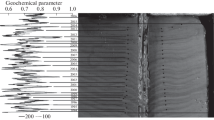Abstract
X-ray fluorescence scanning with synchrotron radiation was performed to study sediment core records of floods in Amur Bay, Sea of Japan. Interlayers of 3–8 mm with abnormally low bromine content were formed by the Razdolnaya River discharge to the central part of the bay during extreme floods, accompanied by severe storms at sea. Such conditions in the region are typical for periods of deep tropical cyclones (typhoons), to which the distinguished interlayers were compared on the timescale. This approach was made possible thanks to the high rate of sedimentation in the bay (3–5 mm/a) and low bioturbation of sediments under anoxic conditions.
Similar content being viewed by others
References
Anikiev V V, Kosenkova S T, Savel’eva N I, Voloshin G Y, Dudarev O V. 2000. Statistical zoning of the spatial distribution of trace elements in the bottom sediments of the Peter the Great Gulf, the Sea of Japan. Geochem. Int., 38: 603–614.
Appleby P G, Oldfield F. 1978. The calculation of lead-210 dates assuming a constant rate of supply of unsupported 210 Pb to the sediment. Catena, 5: 1–8.
Darin A V, Kalugin I A, Rakshun Y V. 2013. Scanning X-ray microanalysis of bottom sediments using synchrotron radiation from the BINP VEPP-3 storage ring. Bulletin Russ. Acad, Sciences: Physics, 77: 182–184.
Donnelly J P. 2005. Evidence of past intense tropical cyclones from backbarrier salt pond sediments: a case study from Isla de Culebrita, Puerto Rico, USA. J. Coastal Res., 42: 201–210.
Goldberg E D. 1963). Geochronology with Pb-210. Proceedings of a Symposium on Radioactive Dating, International Atomic Energy Agency. Vienna, Austria. p.121–131.
Golitsin G S, Vasilieva A A. 2001). Hydro-meteorological hazards. In: Kruk ed. A Series of Natural Hazard of the Russia. Theme volume 5. Moscow. (in Russian)
Gribble G W. 1998. Naturally occurring organohalogen compounds. Acc. Chem. Res., 31: 141–152.
Harvey G R. 1980. A study of the chemistry of iodine and bromine in marine sediments. Mar. Chem., 8: 327–332.
Huang F, Xu S. 2010. Super typhoon activity over the western North Pacific and its relationship with ENSO. Journal of Ocean University of China, 9: 123–128.
Lambert W J, Aharon P, Rodriguez A B. 2008. Catastrophic hurricane history revealed by organic geochemical proxies in coastal lake sediments: a case study of Lake Shelby, Alabama (USA). J. Paleolimnol., 39: 117–131.
Liu K-B, Lu H, Shen C. 2009. Some fundamental misconceptions about paleotempestology. Quatern. Res., 71: 253–254.
Liu K-B, Shen C, Louie K-S. 2001. A 1,000-Year history of typhoon landfalls in Guangdong, Southern China, reconstructed from Chinese historical documentary records. Ann. Assoc. Am. Geogr., 91: 453–464.
Malcolm S, Price N B. 1984. The behavior of iodine and bromine in estuarine surface sediments. Mar. Chem., 15: 263–271.
Mayer L M, Schick L L, Allison M A, Ruttenberg K C, Bentley S J. 2007. Marine vs. terrigenous organic matter in Louisiana coastal sediments: the uses of bromine:organic carbon ratios. Mar. Chem., 107: 244–254.
Mikhailik T A, Tishchenko P Y, Koltunov A M, Tishchenko P P, Shvetsova M G. 2011. The effect of Razdolnaya River on the environmental state of Amur Bay (the Sea of Japan). Water Res., 38: 512–521.
Pacific typhoon season. http://en.academic.ru/dic.nsf/enwiki/1519766.
Plotnikov V V, Tunegolovec V P. 2001. Safety of vital functions. Tutorial, DVGU-Dal’rybvtuz, Vladivostok (in Russian). http://lib.znate.ru/docs/index-173399.html.
Soifer V N, Goryachev V A, Sergeev A F, Astakhov A S, Dudarev O V, Makarov V G, Malkin S D, Shtrombakh Y I, Rodionov Y F, Yashin Y A, Kovalevskaya A M, Gladkikh R V, Rubtsov N P. 1999. Radioactive contamination evolution of bottom sediments in the zone of the 1985 accident on a nuclear submarine in the Chazhma Bight of the Sea of Japan. Russ. Meteorol. Hydrol., 1: 28–40.
Tishchenko P P, Tishchenko P Y, Zvalinskii V I, Sergeev A F. 2011. The carbonate system of Amur Bay (Sea of Japan) under conditions of hypoxia. Oceanology, 51: 235–246.
Tkalin A V, Presley B J, Boothe P N. 1996. Spatial and temporal variations of trace metals in bottom sediments of Peter the Great Bay, the Sea of Japan. Environmental Pollution, 92: 73–78.
Travis J. 2000. Hunting prehistoric hurricanes: Storm-tossed sand offers a record of ancient cyclones. Sci. News, 157: 333–335.
Zhou X, Liu C, Liu Y, Xu H, Wan X. 2011. Changes in tropical cyclone number in the western north Pacific in a warming environment as implied by classical thermodynamics. International Journal of Geosciences, 2: 29–35. http://dx.doi.org/10.4236/ijg.2011.21003.
Author information
Authors and Affiliations
Corresponding author
Rights and permissions
About this article
Cite this article
Kalugin, I., Astakhov, A., Darin, A. et al. Anomalies of bromine in the estuarine sediments as a signal of floods associated with typhoons. Chin. J. Ocean. Limnol. 33, 1489–1495 (2015). https://doi.org/10.1007/s00343-015-4370-9
Received:
Accepted:
Published:
Issue Date:
DOI: https://doi.org/10.1007/s00343-015-4370-9




